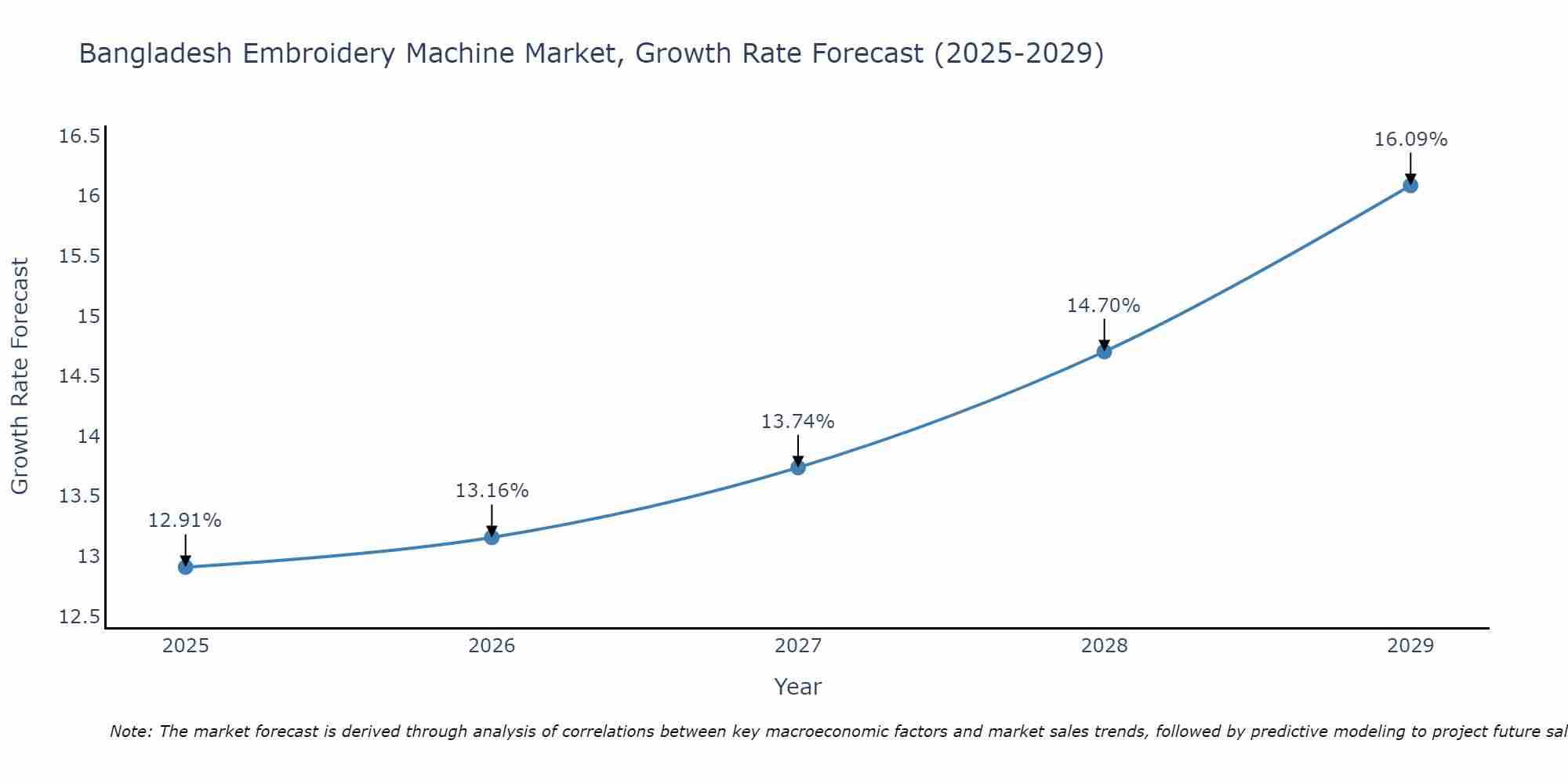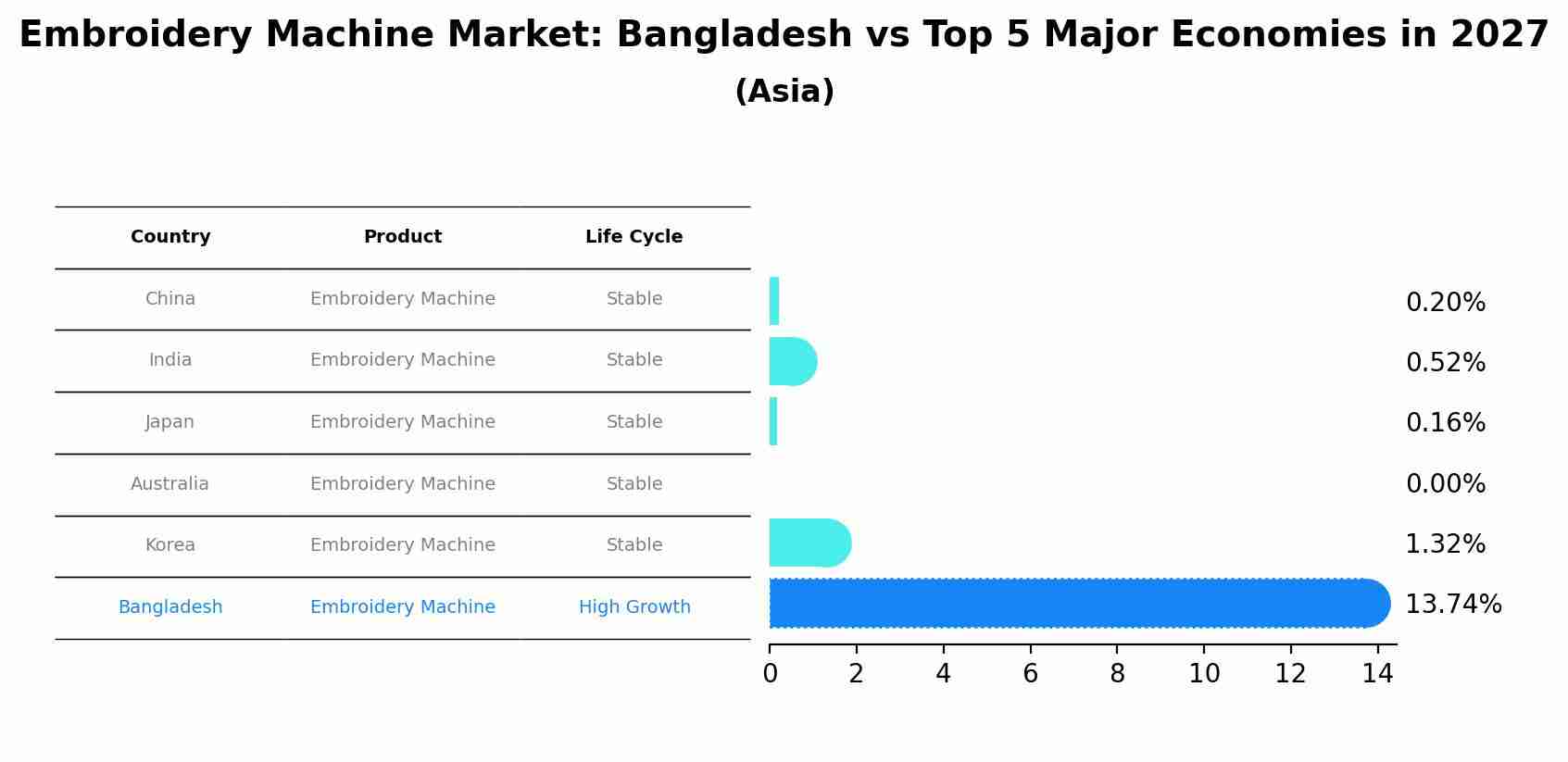Bangladesh Embroidery Machine Market (2025-2031) | Revenue, Companies, Outlook, Growth, Share, Trends, Size, Value, Industry, Forecast & Analysis
| Product Code: ETC063171 | Publication Date: Aug 2021 | Updated Date: Jun 2025 | Product Type: Report | |
| Publisher: 6Wresearch | Author: Vasudha | No. of Pages: 70 | No. of Figures: 35 | No. of Tables: 5 |
Bangladesh Embroidery Machine Market Size Growth Rate
The Bangladesh Embroidery Machine Market is poised for steady growth rate improvements from 2025 to 2029. From 12.91% in 2025, the growth rate steadily ascends to 16.09% in 2029.

Embroidery Machine Market: Bangladesh vs Top 5 Major Economies in 2027 (Asia)
By 2027, the Embroidery Machine market in Bangladesh is anticipated to reach a growth rate of 13.74%, as part of an increasingly competitive Asia region, where China remains at the forefront, supported by India, Japan, Australia and South Korea, driving innovations and market adoption across sectors.

Bangladesh Embroidery Machine Market Overview
The Bangladesh Embroidery Machine Market is experiencing steady growth driven by the country`s expanding textile and garment industry. With the demand for intricate and high-quality embroidery on the rise, there is a growing need for advanced embroidery machines that can cater to a wide range of designs and materials. The market consists of a mix of domestic and international players offering a variety of embroidery machines, from single-head machines for small-scale businesses to multi-head machines for large-scale production units. Key factors influencing market growth include technological advancements, increasing disposable income, and the growing trend of customization in the garment industry. As the textile sector in Bangladesh continues to thrive, the embroidery machine market is poised for further expansion in the coming years.
Bangladesh Embroidery Machine Market Trends
The Bangladesh Embroidery Machine Market is witnessing a growing demand for advanced computerized embroidery machines that offer high precision and fast production capabilities. This trend is driven by the increasing preference for intricate and detailed embroidery designs in the fashion and textile industries. Additionally, the market is seeing a surge in the adoption of multi-head embroidery machines that can handle multiple designs simultaneously, leading to improved efficiency and productivity for manufacturers. Moreover, there is a growing emphasis on environmentally friendly and energy-efficient embroidery machines to reduce operational costs and environmental impact. Overall, the Bangladesh Embroidery Machine Market is evolving towards technologically advanced, high-speed machines that can meet the increasing demands for quality and customization in the textile and garment sectors.
Bangladesh Embroidery Machine Market Challenges
In the Bangladesh Embroidery Machine Market, several challenges are faced, including the high initial investment cost for purchasing embroidery machines, limited access to advanced technology and machinery due to the relatively small market size, inadequate training and skilled labor for operating and maintaining the machines effectively, and fierce competition among domestic and international manufacturers. Additionally, factors such as fluctuating raw material costs, lack of government support and incentives for the embroidery industry, and logistical issues in terms of transportation and distribution can also pose challenges for businesses operating in this market. Overcoming these obstacles requires strategic planning, investment in training programs, collaboration with technology providers, and efforts to enhance market penetration and brand awareness to stay competitive in the evolving embroidery machine market in Bangladesh.
Bangladesh Embroidery Machine Market Investment Opportunities
The Bangladesh Embroidery Machine Market presents promising investment opportunities due to the country`s growing textile and garment industry. With a strong demand for embroidered fabrics and garments in both domestic and international markets, the need for advanced and efficient embroidery machines is high. Investors can explore opportunities in supplying high-quality embroidery machines to textile manufacturers, offering maintenance and repair services, or even setting up training centers to educate workers on machine operation. Additionally, with the government focusing on promoting the textile sector through various initiatives and incentives, investing in the Bangladesh Embroidery Machine Market can be a strategic move for long-term growth and profitability.
Bangladesh Embroidery Machine Market Government Policy
The Bangladesh government has implemented various policies to support the Embroidery Machine Market in the country. These policies include providing financial incentives and subsidies to promote the growth of the industry, as well as offering tax breaks to manufacturers and exporters of embroidery machines. Additionally, the government has focused on improving infrastructure and providing technical training to enhance the skills of the workforce in this sector. Furthermore, there are regulations in place to ensure the quality and safety standards of embroidery machines produced and sold in the market. Overall, these government policies aim to boost the competitiveness and innovation of the Bangladesh Embroidery Machine Market while also ensuring sustainable growth and compliance with international standards.
Bangladesh Embroidery Machine Market Future Outlook
The Bangladesh Embroidery Machine Market is expected to experience steady growth in the coming years due to factors such as increasing demand for customized and intricately designed textiles, particularly in the garment and textile industries. The market is likely to be driven by technological advancements leading to the introduction of more efficient and advanced embroidery machines. Additionally, the growing trend of digitalization and automation in the textile sector is expected to further boost the demand for embroidery machines in Bangladesh. With the government`s focus on promoting the textile and garment industries as key drivers of economic growth, the market is anticipated to witness a positive outlook with opportunities for both domestic manufacturers and international players to expand their presence and offerings in the country.
Key Highlights of the Report:
- Bangladesh Embroidery Machine Market Outlook
- Market Size of Bangladesh Embroidery Machine Market, 2021
- Forecast of Bangladesh Embroidery Machine Market, 2031
- Historical Data and Forecast of Bangladesh Embroidery Machine Revenues & Volume for the Period 2021 - 2031
- Bangladesh Embroidery Machine Market Trend Evolution
- Bangladesh Embroidery Machine Market Drivers and Challenges
- Bangladesh Embroidery Machine Price Trends
- Bangladesh Embroidery Machine Porter's Five Forces
- Bangladesh Embroidery Machine Industry Life Cycle
- Historical Data and Forecast of Bangladesh Embroidery Machine Market Revenues & Volume By Product Type for the Period 2021 - 2031
- Historical Data and Forecast of Bangladesh Embroidery Machine Market Revenues & Volume By Single Head for the Period 2021 - 2031
- Historical Data and Forecast of Bangladesh Embroidery Machine Market Revenues & Volume By Multi Head for the Period 2021 - 2031
- Historical Data and Forecast of Bangladesh Embroidery Machine Market Revenues & Volume By Applications for the Period 2021 - 2031
- Historical Data and Forecast of Bangladesh Embroidery Machine Market Revenues & Volume By Household for the Period 2021 - 2031
- Historical Data and Forecast of Bangladesh Embroidery Machine Market Revenues & Volume By Commercial for the Period 2021 - 2031
- Historical Data and Forecast of Bangladesh Embroidery Machine Market Revenues & Volume By Industrial for the Period 2021 - 2031
- Bangladesh Embroidery Machine Import Export Trade Statistics
- Market Opportunity Assessment By Product Type
- Market Opportunity Assessment By Applications
- Bangladesh Embroidery Machine Top Companies Market Share
- Bangladesh Embroidery Machine Competitive Benchmarking By Technical and Operational Parameters
- Bangladesh Embroidery Machine Company Profiles
- Bangladesh Embroidery Machine Key Strategic Recommendations
Frequently Asked Questions About the Market Study (FAQs):
1 Executive Summary |
2 Introduction |
2.1 Key Highlights of the Report |
2.2 Report Description |
2.3 Market Scope & Segmentation |
2.4 Research Methodology |
2.5 Assumptions |
3 Bangladesh Embroidery Machine Market Overview |
3.1 Bangladesh Country Macro Economic Indicators |
3.2 Bangladesh Embroidery Machine Market Revenues & Volume, 2021 & 2031F |
3.3 Bangladesh Embroidery Machine Market - Industry Life Cycle |
3.4 Bangladesh Embroidery Machine Market - Porter's Five Forces |
3.5 Bangladesh Embroidery Machine Market Revenues & Volume Share, By Product Type, 2021 & 2031F |
3.6 Bangladesh Embroidery Machine Market Revenues & Volume Share, By Applications, 2021 & 2031F |
4 Bangladesh Embroidery Machine Market Dynamics |
4.1 Impact Analysis |
4.2 Market Drivers |
4.3 Market Restraints |
5 Bangladesh Embroidery Machine Market Trends |
6 Bangladesh Embroidery Machine Market, By Types |
6.1 Bangladesh Embroidery Machine Market, By Product Type |
6.1.1 Overview and Analysis |
6.1.2 Bangladesh Embroidery Machine Market Revenues & Volume, By Product Type, 2018 - 2027F |
6.1.3 Bangladesh Embroidery Machine Market Revenues & Volume, By Single Head, 2018 - 2027F |
6.1.4 Bangladesh Embroidery Machine Market Revenues & Volume, By Multi Head, 2018 - 2027F |
6.2 Bangladesh Embroidery Machine Market, By Applications |
6.2.1 Overview and Analysis |
6.2.2 Bangladesh Embroidery Machine Market Revenues & Volume, By Household, 2018 - 2027F |
6.2.3 Bangladesh Embroidery Machine Market Revenues & Volume, By Commercial, 2018 - 2027F |
6.2.4 Bangladesh Embroidery Machine Market Revenues & Volume, By Industrial, 2018 - 2027F |
7 Bangladesh Embroidery Machine Market Import-Export Trade Statistics |
7.1 Bangladesh Embroidery Machine Market Export to Major Countries |
7.2 Bangladesh Embroidery Machine Market Imports from Major Countries |
8 Bangladesh Embroidery Machine Market Key Performance Indicators |
9 Bangladesh Embroidery Machine Market - Opportunity Assessment |
9.1 Bangladesh Embroidery Machine Market Opportunity Assessment, By Product Type, 2021 & 2031F |
9.2 Bangladesh Embroidery Machine Market Opportunity Assessment, By Applications, 2021 & 2031F |
10 Bangladesh Embroidery Machine Market - Competitive Landscape |
10.1 Bangladesh Embroidery Machine Market Revenue Share, By Companies, 2021 |
10.2 Bangladesh Embroidery Machine Market Competitive Benchmarking, By Operating and Technical Parameters |
11 Company Profiles |
12 Recommendations |
13 Disclaimer |
- Single User License$ 1,995
- Department License$ 2,400
- Site License$ 3,120
- Global License$ 3,795
Search
Thought Leadership and Analyst Meet
Our Clients
Related Reports
- Afghanistan Apparel Market (2026-2032) | Growth, Outlook, Industry, Segmentation, Forecast, Size, Companies, Trends, Value, Share, Analysis & Revenue
- Canada Oil and Gas Market (2026-2032) | Share, Segmentation, Value, Industry, Trends, Forecast, Analysis, Size & Revenue, Growth, Competitive Landscape, Outlook, Companies
- Germany Breakfast Food Market (2026-2032) | Industry, Share, Growth, Size, Companies, Value, Analysis, Revenue, Trends, Forecast & Outlook
- Australia Briquette Market (2025-2031) | Growth, Size, Revenue, Forecast, Analysis, Trends, Value, Share, Industry & Companies
- Vietnam System Integrator Market (2025-2031) | Size, Companies, Analysis, Industry, Value, Forecast, Growth, Trends, Revenue & Share
- ASEAN and Thailand Brain Health Supplements Market (2025-2031) | Strategy, Consumer Insights, Analysis, Investment Trends, Opportunities, Growth, Size, Share, Industry, Revenue, Segments, Value, Segmentation, Supply, Forecast, Restraints, Outlook, Competition, Drivers, Trends, Demand, Pricing Analysis, Competitive, Strategic Insights, Companies, Challenges
- ASEAN Bearings Market (2025-2031) | Strategy, Consumer Insights, Analysis, Investment Trends, Opportunities, Growth, Size, Share, Industry, Revenue, Segments, Value, Segmentation, Supply, Forecast, Restraints, Outlook, Competition, Drivers, Trends, Demand, Pricing Analysis, Competitive, Strategic Insights, Companies, Challenges
- Europe Flooring Market (2025-2031) | Outlook, Share, Industry, Trends, Forecast, Companies, Revenue, Size, Analysis, Growth & Value
- Saudi Arabia Manlift Market (2025-2031) | Outlook, Size, Growth, Trends, Companies, Industry, Revenue, Value, Share, Forecast & Analysis
- Uganda Excavator, Crane, and Wheel Loaders Market (2025-2031) | Strategy, Consumer Insights, Analysis, Investment Trends, Opportunities, Growth, Size, Share, Industry, Revenue, Segments, Value, Segmentation, Supply, Forecast, Restraints, Outlook, Competition, Drivers, Trends, Demand, Pricing Analysis, Competitive, Strategic Insights, Companies, Challenges
Industry Events and Analyst Meet
Whitepaper
- Middle East & Africa Commercial Security Market Click here to view more.
- Middle East & Africa Fire Safety Systems & Equipment Market Click here to view more.
- GCC Drone Market Click here to view more.
- Middle East Lighting Fixture Market Click here to view more.
- GCC Physical & Perimeter Security Market Click here to view more.
6WResearch In News
- Doha a strategic location for EV manufacturing hub: IPA Qatar
- Demand for luxury TVs surging in the GCC, says Samsung
- Empowering Growth: The Thriving Journey of Bangladesh’s Cable Industry
- Demand for luxury TVs surging in the GCC, says Samsung
- Video call with a traditional healer? Once unthinkable, it’s now common in South Africa
- Intelligent Buildings To Smooth GCC’s Path To Net Zero


















